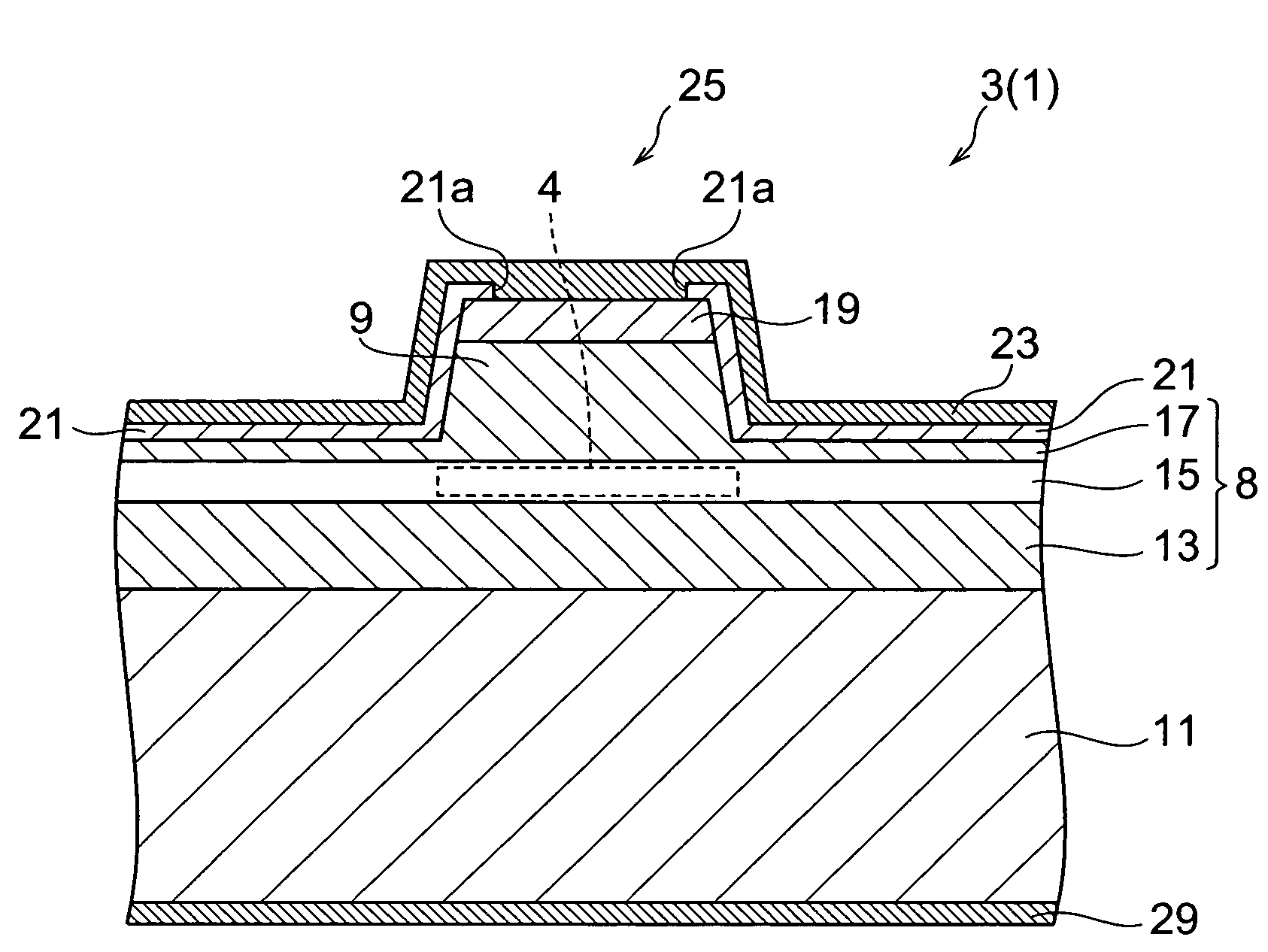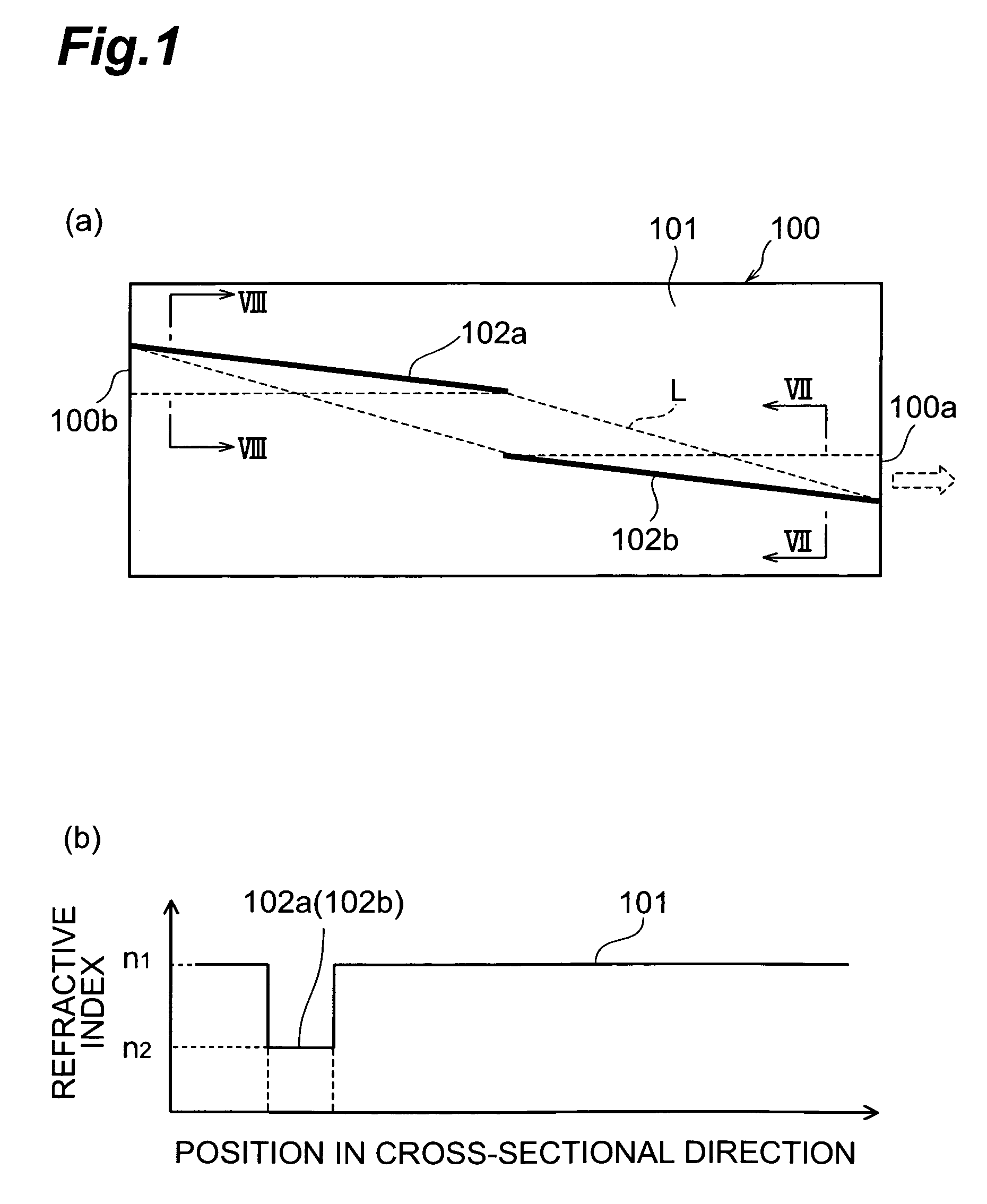Semiconductor laser element and semiconductor laser element array
a laser element and semiconductor technology, applied in the direction of lasers, semiconductor lasers, optical resonator shape and construction, etc., can solve the problems of complex lens shape, high manufacturing cost, and small area of the emitting end, so as to reduce the emission angle reduce the effect of manufacturing cos
- Summary
- Abstract
- Description
- Claims
- Application Information
AI Technical Summary
Benefits of technology
Problems solved by technology
Method used
Image
Examples
first embodiment
[0050]FIG. 2 is a perspective view showing the configuration of the semiconductor laser element array to which the first embodiment of the semiconductor laser element according to the present invention is applied (an embodiment of the semiconductor laser element array according to the present invention). As shown in FIG. 2, the semiconductor laser element array 1 has a plurality of semiconductor laser elements 3 which have an integral structure. The number of semiconductor laser elements 3 of the semiconductor laser element array 1 can be arbitrary, and when there is only one, it is not an array but a single semiconductor laser element. The semiconductor laser element array 1 has a light emitting face 1a and light reflecting face 1b, which face each other, and on the light emitting face 1a, a laser beam emitting end 4a of each semiconductor laser element 3 is placed in the horizontal direction. Each of the plurality of semiconductor laser elements 3 has a convex portion 25 which is ...
first application example of first embodiment
[0076]Next, a first application example of the semiconductor laser element 3 according to the first embodiment will be explained. In the first application example, the angle θ formed by the side faces 4c and 4d of the refractive index type waveguide 4 and the direction A, which matches each normal line of the light emitting end 4a and the light reflecting end 4b, is set to the critical complementary angle 4° based on the refractive index difference between the inside and outside the refractive index type waveguide 4. The space between the side face 4c and side face 4d of the refractive index type waveguide 4 (width of the refractive index type waveguide 4) is 40 μm, and the distance between the laser beam emitting end 4a and the laser beam reflecting end 4b (length of the refractive index type waveguide 4) is set to 1200 μm, which can implement the optical path in FIG. 7. The waveguide width of a conventional single mode type semiconductor laser element (including the semiconductor ...
second application example of first embodiment
[0080]Next, as a second application example of the first embodiment, a semiconductor element array 1, having a plurality of semiconductor laser elements each of which have the same structure of the semiconductor laser element 3 of the first embodiment having the above structure, will be explained. In the second application example, 50 ridge portions are formed in 1 cm with a 200 μm pitch. The area (a) of FIG. 12 is a graph showing the current vs. optical output characteristics of the semiconductor laser element array of the second application example. As shown in the graph of the area (a), the current supplied to each semiconductor laser element of the semiconductor laser element array and the laser beam output has a linear correlation, and kinks are not generated. The slope efficiency of the element according to this graph is 0.75 W / A, which is equivalent to the case of a single semiconductor laser element (see FIG. 10). Therefore, as compared with the resonator of the Internationa...
PUM
 Login to View More
Login to View More Abstract
Description
Claims
Application Information
 Login to View More
Login to View More - R&D
- Intellectual Property
- Life Sciences
- Materials
- Tech Scout
- Unparalleled Data Quality
- Higher Quality Content
- 60% Fewer Hallucinations
Browse by: Latest US Patents, China's latest patents, Technical Efficacy Thesaurus, Application Domain, Technology Topic, Popular Technical Reports.
© 2025 PatSnap. All rights reserved.Legal|Privacy policy|Modern Slavery Act Transparency Statement|Sitemap|About US| Contact US: help@patsnap.com



